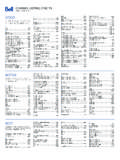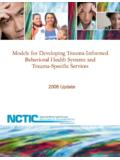Transcription of Interdisciplinary Patient/Family Education Record
1 Interdisciplinary Patient/Family Education Record Guidelines for use of the paper form A. Purpose To outline the method for documentation on the paper Interdisciplinary Patient/Family Education Record B. General description of form/special considerations 1. The Interdisciplinary Patient and family Education Record provides a central location for documenting patient and family Education . 2. The Record is double sided and has a purple stripe on the right side. An additional Patient and family Education Continuation sheet is added as needed for detailed documentation. 3. The form is completed in black ink at the New York Weill Cornell Center and in blue or black ink at the Columbia Presbyterian Center. 4. A new form must be initiated for each inpatient admission. In ambulatory services, it is an ongoing document. 5. Teaching protocols with pre-printed objectives have been approved for use on certain topics, such as Diabetes and Ambulatory Obstetrics.
2 When these protocols are used, an additional form is not needed. Use the form in the same manner as described below with the exception that all topics pertaining to the diagnosis have been pre-printed on the form. Other topics can be written in. 6. Information documented on the paper Patient and family Education Interdisciplinary Record includes teaching related to the following topics: a. Disease process, condition, health promotion and wellness such as: pathophysiology; description of condition or illness; reportable signs and symptoms, such as shortness of breath, pain, fatigue, drainage, etc.; health promotion and wellness issues such as quitting smoking, weight management. b. Treatment, procedures and pain management c. Nutrition interventions and/or modified diet such as specific diet plan; identifying foods to avoid; importance of maintaining ordered diet, etc. d. Medications, including drug food interactions e.
3 Daily activities, safe and effective use of equipment, exercises and /or rehabilitation techniques: such as strengthening exercises, range of motion, etc.; equipment use, such as incentive spirometry, CPM, crutches, suction machines, etc.; and rehabilitation plans. f. Available community resources and access, follow up, regimen/prescription for continued care: Instructions pertaining to the use of community resources and follow up care, such as referrals to the American Heart Association, Nutrition Consultation Service, Cardiac Rehabilitation, need to follow up with physician or therapist, etc. 7. Departmental/Divisional variations for use of the form are described below. a. In Ambulatory Services areas, a new form is used for each visit in areas using IMNET imaging, if a scanned copy is not available. In other Ambulatory Services areas, the form is an ongoing Record , with documentation continuing from one visit to the next on the same form.
4 Additional records and Continuation Sheets are added as needed. Some Ambulatory areas are exempt from use of this form. b. In Psychiatry, documentation on this form must occur with the first teaching encounter and when the learning outcome has been achieved. c. In Rehabilitation, documentation on this form must occur when therapists initiate or change Patient/Family Education . Documentation on this form will comply with Documentation Guidelines for Rehabilitation Medicine . Reference to this form in rehabilitation notes may be made to prevent duplicate documentation. d. In ECLIPSYS, nursing documentation of patient teaching about safety will be placed in the ECLIPSYS Daily Nursing Assessment section, consisting ONLY of the following: safety issues and routine repeat instruction relative to use of side rails, routine activity, ambulating, and ordered activity such as Bed rest, calling for assistance, use of call bell, orientation to unit, use of proper footwear, use of bed controls, and room lights, e.
5 All other patient teaching is documented on the Interdisciplinary pt/ family Education Record . C. Persons responsible Medical Providers, RNs, Nutritionists/Dietitians, Social Workers, Respiratory Therapists, Physical Therapists, Occupational Therapists. Pharmacists, and other health care professionals involved in the care and Education of the patient and family . LPNs, Mental Health Workers, Psychiatric Technicians and PCTs may document routine information and the reinforcement of teaching initially provided by the RN. D. Instructions for use of the paper form: 1. Addressograph form in upper right hand corner. 2. Instructions to Complete Section I a. DATE: Date each entry. b. LEARNER: Identify the learner using the learner key . Specify the family member and/or caregiver. Example: patient, spouse, mother, father. Specify name and relationship of relative/friend/caregiver if other than spouse, mother, or father.
6 Example: son - Michael c. OBJECTIVES: 1. Identify the objective by writing the topic in the Objectives Column. The terms used should complete the phrase written at the top of the column: The Patient/Family is able to describe &/or demonstrate knowledge or skills related to _____ . Example: The Patient/Family is able to describe and/or demonstrate knowledge or skill related to Low salt diet . In this case, only the words low salt diet would need to be written in the objectives column. Protocols have pre-printed objectives. d. HOW: Specify the method of teaching by using the key for How and placing the appropriate letters in the How column. More than one How letter key may be entered. e. EVALUATION: Document the evaluation of learning with the Evaluation key as above. More than one Evaluation letter key may be entered.
7 F. BARRIERS: Indicate any barriers to learning using the Barriers key. More than one Barrier number key may be entered. Explain barrier as needed in Section 2. g. SIGNATURE/TITLE: Place signature and title after each entry. 3. Instructions to complete Section 2 of the form: a. This section is used to more fully describe barriers to learning, identify resources used, identify a translator, and document additional comments. Example: If language is selected as a barrier to learning, indicate what the language is in Section 2. If cultural barrier is selected, briefly describe the cultural barrier. b . Explanations should be concise. Once a barrier is explained in section 2, it does not need to be explained again in a subsequent entry, unless a change in the explanation is needed. c. Identify the name of the resource used such as Cardiac Rehabilitation Services Program brochure d.
8 If additional space is required, a Patient and family Education Continuation sheet can accompany the form with a detailed narrative description. 4. A completed sample appears on the following pages. , reviewed 8/00, revised 3/02














